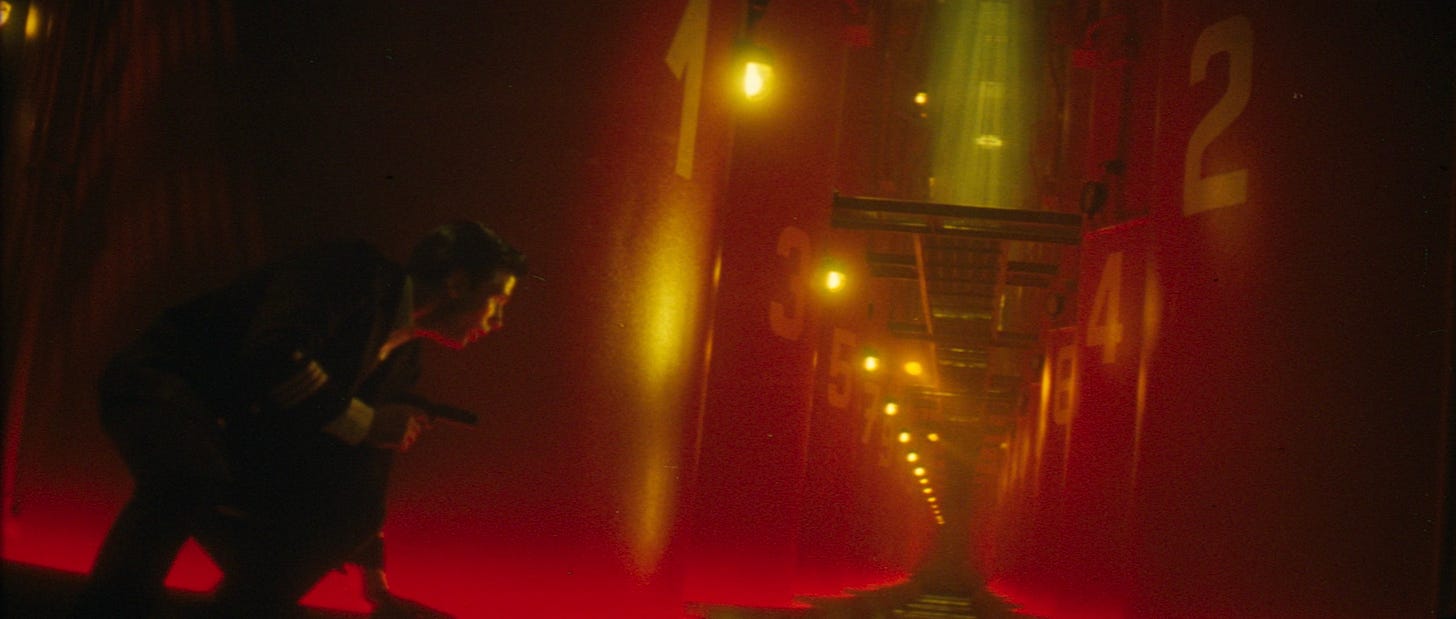What Movies Can Look Like
A few words about a well-lit submarine
Some years ago, I stumbled across a project by a group of Star Wars fans who’d taken to scanning theatrical release prints of the original 1977 film, in its original pre-Special Edition form. With no official restoration or release of the unaltered Star Wars in sight, these dedicated fans had jerry-rigged a 35mm projector and camera to make their scans, and then spent years cleaning them up and assembling them into their own restoration. That project was followed by further even better quality restorations from better scans of better prints. Many already know about 4K77, the ultimate end of all this, a version of the film that surpasses all others, official and not, in quality and care. My interest in the Star Wars scans led me into corners of the internet where film enthusiasts have been collecting, scanning and restoring (or semi-restoring) prints of all kinds of movies. In many cases, unlike with 4K77 and its affiliated projects, these other scans are not released as attempts to literally outmatch any official Blu-ray release, but to capture something closer to what moviegoers might have actually seen projected in look and feel.
It’s an aim not devoid of merit, and in most cases, I love these scans. They’re often my preferred way to watch the films in question. A scan of Se7en that’s out there in the world might not look exactly like the 35mm print I’ve seen projected more than once here in Toronto, but the scraggy feel of it certainly feels more suited to the film than any Blu-ray or 4K release, what with David Fincher’s penchant for as slick and clean an image as he can get. I’ve seen beautiful scans of Jurassic Park and Face-Off and The Thing and Fantasia and Ashes of Time and I could go on and on. The other night, I put on another, recently acuqired: The Hunt for Red October. It looks glorious.
Now, obviously The Hunt for Red October is a key text in the Five-Star Three-Star canon, and one I’m sure I’ll get to eventually, but this go around I really only had one thing on my mind. Given that I was watching it via a 35mm print scan, I was particularly attentive to how the movie looked. Great, in a word. But more than that, I found myself utterly mesmerized by cinematographer Jan de Bont’s photography. The man was no slouch, and Die Hard is one of the best looking action movies ever made, so it stands to reason Red October would look good, too. More than looking good, though, it has real style.
Stuck within the confines of a submarine, telling a story that’s mostly comprised of people standing around talking, de Bont amd director John McTiernan get creative. Not in any wild way. This isn’t Rian Johnson directing a bottle episode of Breaking Bad, admirably swinging the camera around every which way. De Bont and McTiernan instead create a whole visual language for their film, turning the limitations of the environment into assets. Lighting sources are peppered throughout the dark interior, illuminating characters with beautiful contrast from interesting angles, often from below as often as above.
In one incredible shot, the camera pulls out to reveal Alec Baldwin with a gun in the sub’s reactor room, giant, tall red cylinders lining the path before him, and even having seen the film several times before, I nearly fell out of my chair (or in this case rolled off my bed). I studied the shot for a while, looking at its odd, almost impressionistic lighting, its canted angle, the beauty of the deep red in the frame. It seems so real and unreal, and I assume that much of it is a set exention matte painting. There’s no reason the shot should look the way that it does, except for the fact that it’s beautiful. Yet, it’s more than just beautiful. It’s stylistically coherent, serving to enlarge the sense of scale inside the sub while maintaining the visual attributes of its more claustrophobic sets. It’s all for the tension, baby, and holy shit is that scene tense.
There’s no one way movies used to look, and it’s not like movies don’t still look good much of the time. Some even have style. But I watch a movie like The Hunt for Red October, and it makes me dream of a world where this level of visual craft was still regularly being applied to blockbuster movies. Or studio movies in general. A lot of indie movies, too, honestly. Perhaps not fair to use a movie shot by a great like de Bont as my yardstick, but the truth is, plenty of movies from the era display the same sort of consideration. Not artsy-farsty-ness, but an understanding that style and story can be one and the same, and that a movies’ beauty can be inseparable from its effectiveness. Movies can look like The Hunt for Red October.


